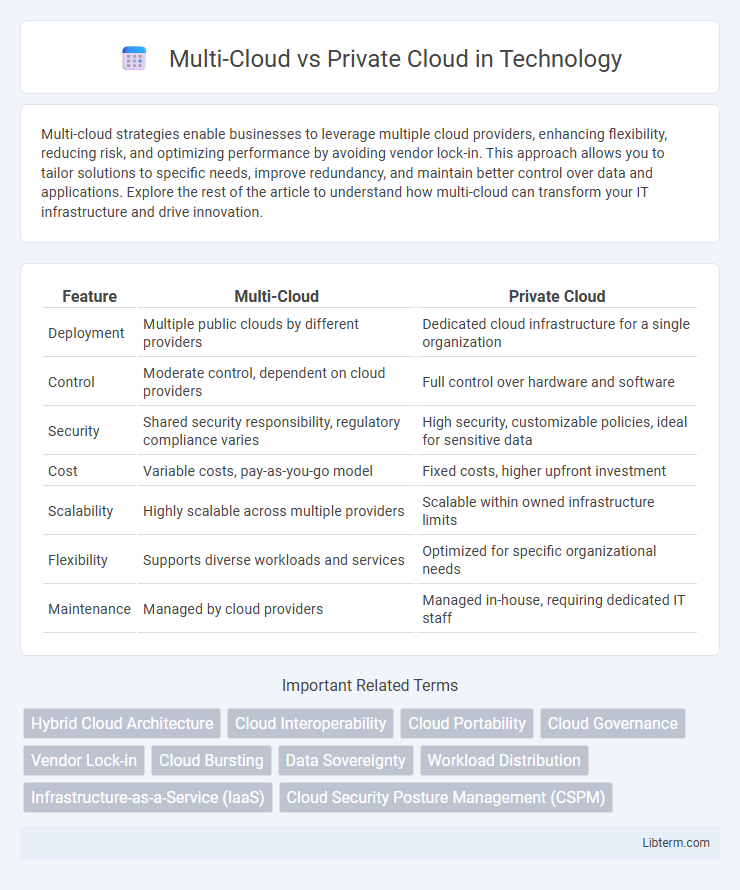Multi-cloud strategies enable businesses to leverage multiple cloud providers, enhancing flexibility, reducing risk, and optimizing performance by avoiding vendor lock-in. This approach allows you to tailor solutions to specific needs, improve redundancy, and maintain better control over data and applications. Explore the rest of the article to understand how multi-cloud can transform your IT infrastructure and drive innovation.
Table of Comparison
| Feature | Multi-Cloud | Private Cloud |
|---|---|---|
| Deployment | Multiple public clouds by different providers | Dedicated cloud infrastructure for a single organization |
| Control | Moderate control, dependent on cloud providers | Full control over hardware and software |
| Security | Shared security responsibility, regulatory compliance varies | High security, customizable policies, ideal for sensitive data |
| Cost | Variable costs, pay-as-you-go model | Fixed costs, higher upfront investment |
| Scalability | Highly scalable across multiple providers | Scalable within owned infrastructure limits |
| Flexibility | Supports diverse workloads and services | Optimized for specific organizational needs |
| Maintenance | Managed by cloud providers | Managed in-house, requiring dedicated IT staff |
Introduction to Multi-Cloud and Private Cloud
Multi-cloud environments leverage multiple cloud service providers to optimize performance, cost, and resilience, offering organizations flexibility and redundancy. Private clouds provide dedicated infrastructure managed either on-premises or by third-party vendors, emphasizing enhanced security, compliance, and control. Both cloud models support scalable computing resources but differ in deployment complexity, governance, and customization.
Key Differences Between Multi-Cloud and Private Cloud
Multi-cloud environments utilize multiple public cloud services from different providers to enhance redundancy, flexibility, and avoid vendor lock-in, while private clouds offer dedicated infrastructure within an organization for greater control and security. Multi-cloud strategies emphasize scalability and diverse service options across providers like AWS, Azure, and Google Cloud, whereas private clouds focus on customized, on-premises or hosted solutions tailored to specific compliance and governance needs. Resource management in multi-cloud requires advanced orchestration tools to handle varied APIs and billing models, contrasting with private cloud's centralized management and consistent performance metrics.
Advantages of Multi-Cloud Environments
Multi-cloud environments provide enhanced flexibility by allowing organizations to leverage the unique strengths of multiple cloud service providers, improving resilience and reducing dependency on a single vendor. They offer optimized cost management through tailored resource allocation and workload distribution across diverse platforms such as AWS, Azure, and Google Cloud. Improved disaster recovery and business continuity are achieved by geographically dispersed data centers and redundant infrastructure inherent in multi-cloud strategies.
Benefits of Private Cloud Solutions
Private cloud solutions offer enhanced data security and compliance by enabling organizations to maintain complete control over their infrastructure. They provide customizable environments that optimize performance and support specific business requirements without the risks associated with shared resources. Cost efficiency is improved over time through predictable resource allocation and reduced dependency on external providers.
Security Considerations: Multi-Cloud vs Private Cloud
Security considerations in multi-cloud environments involve complex challenges such as maintaining consistent access controls, protecting data across diverse platforms, and managing compliance with varied regulatory standards. Private clouds offer enhanced security through dedicated infrastructure, allowing organizations to implement customized security policies and maintain greater control over data residency. While multi-cloud strategies provide redundancy and flexibility, private clouds reduce exposure to external threats by isolating workloads within a single, controlled environment.
Cost Comparison: Multi-Cloud vs Private Cloud
Multi-cloud environments often incur higher operational costs due to the complexity of managing multiple platforms, data transfer fees, and licensing across various providers, whereas private clouds demand substantial upfront capital expenditure for infrastructure but offer greater cost predictability. Private cloud solutions benefit from consolidated resource usage and potential energy savings, which can reduce long-term expenses despite initial investments in hardware and maintenance. Cost efficiency in multi-cloud depends on workload optimization and provider selection, while private cloud favors organizations with stable demand and strict data control requirements.
Performance and Scalability in Both Cloud Models
Multi-cloud environments offer enhanced scalability by distributing workloads across multiple service providers, reducing latency, and improving redundancy, which leads to optimized performance under variable demand. Private clouds provide consistent, high-performance compute resources tailored to specific organizational needs, ensuring low latency and greater control over critical applications. Performance in multi-cloud setups benefits from geographic resource allocation, while private clouds excel in predictable scalability through dedicated infrastructure management.
Use Cases Best Suited for Multi-Cloud
Multi-cloud environments excel in scenarios requiring workload distribution across diverse cloud platforms for enhanced redundancy, compliance, and cost optimization. Businesses with global operations benefit from multi-cloud by leveraging regional cloud providers to meet data sovereignty laws and reduce latency. Development teams utilize multi-cloud setups for disaster recovery strategies, seamless cloud bursting, and avoiding vendor lock-in while optimizing performance across specialized cloud services.
When to Choose Private Cloud Over Multi-Cloud
Choosing a private cloud over a multi-cloud environment is ideal when an organization requires enhanced security, strict compliance with regulatory standards, and complete control over data and infrastructure. Private cloud solutions offer dedicated resources that ensure consistent performance and reduce risks of data breaches. Enterprises with predictable workloads and a need for customized infrastructure benefit from the stability and privacy of private cloud deployments.
Future Trends in Enterprise Cloud Adoption
Future trends in enterprise cloud adoption indicate a growing preference for multi-cloud strategies due to their flexibility, risk mitigation, and vendor diversity. Enterprises increasingly invest in advanced cloud management platforms and AI-powered analytics to optimize multi-cloud environments and enhance workload portability. Despite this, private cloud solutions continue to evolve with stronger security features and compliance capabilities, attracting organizations with stringent data privacy requirements.
Multi-Cloud Infographic

 libterm.com
libterm.com